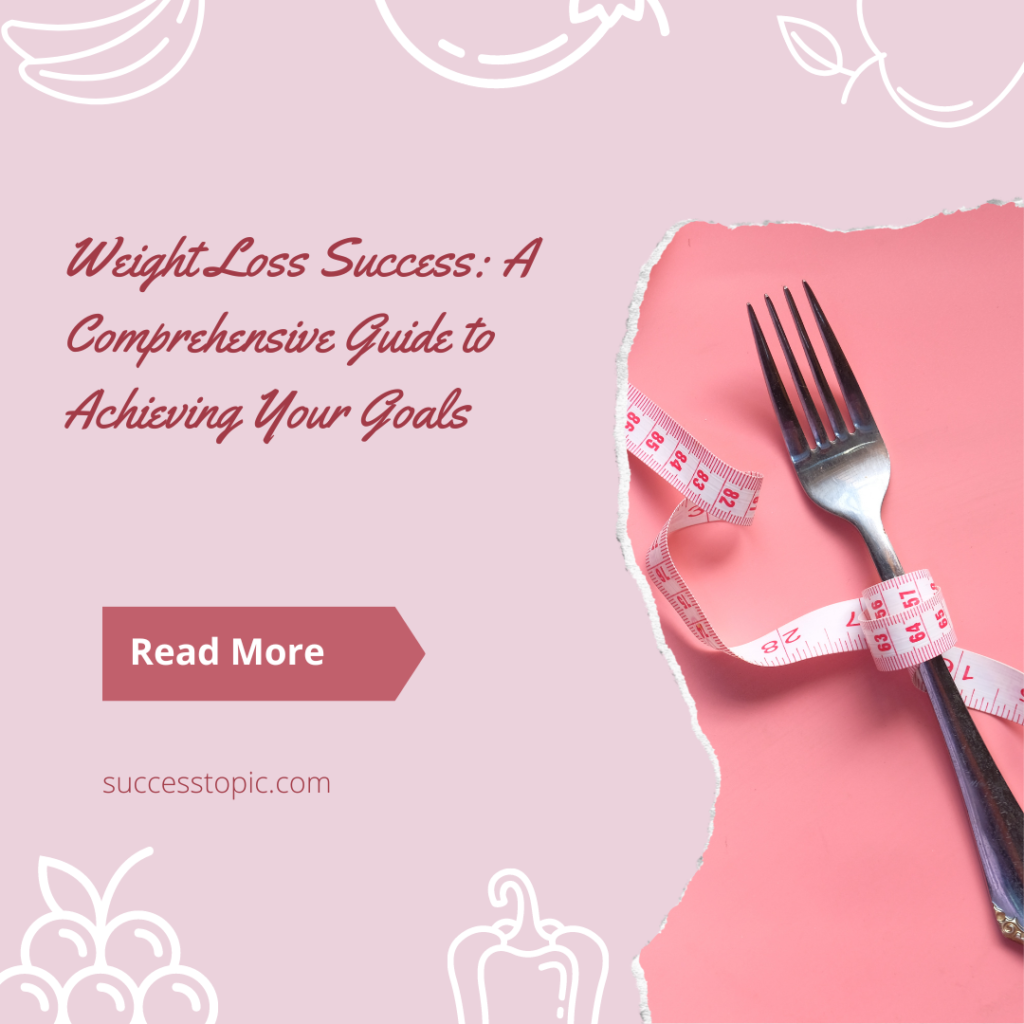
Weight loss success is a journey that requires dedication, discipline, and a well-rounded approach to achieve lasting results. In this article, we will explore various strategies, tips, and habits that can help you reach your weight loss goals and maintain a healthy lifestyle.
What is a Weight Loss Success?
Weight loss success refers to achieving a person’s weight loss goals through a combination of healthy eating habits, regular physical activity, and lifestyle changes. Weight loss success is not just about reaching a specific number on the scale but also maintaining the weight loss goals and adopting a healthier lifestyle for the long term. It often involves losing excess body weight at a steady and sustainable pace while improving overall health and well-being.

Why Weight loss success is Important?
Weight loss success is important for several reasons, including:
Improved physical health
Losing excess weight can reduce the risk of developing chronic health conditions, such as heart disease, type 2 diabetes, high blood pressure, and certain types of cancer. It can also help improve cholesterol levels, blood sugar control, and overall cardiovascular health.
Enhanced mental well-being
Achieving weight loss goals can increase self-confidence, self-esteem, and a more positive body image. Additionally, regular exercise and a balanced diet can contribute to better mental health by reducing stress, anxiety, and symptoms of depression.
Increased energy levels
Carrying excess weight can lead to fatigue and decreased energy levels. Successful weight loss can result in increased energy levels, making it easier to engage in daily activities and maintain an active lifestyle.
Better sleep quality
Excess weight, particularly around the neck area, can contribute to sleep apnea and other sleep disturbances. Losing weight can improve sleep quality, improving overall health and well-being.
Reduced joint pain
Excess weight stresses joints, particularly the knees, hips, and lower back. Weight loss can help alleviate joint pain and reduce the risk of developing osteoarthritis.
Improved mobility and flexibility
Successful weight loss can enhance mobility, flexibility, and overall physical function, making engaging in daily activities and maintaining an active lifestyle easier.
Long-term health benefits
Achieving and maintaining weight loss success can result in long-term health benefits, including a reduced risk of developing chronic health conditions and increased life expectancy.
Positive lifestyle changes
The process of achieving weight loss goals often involves adopting healthier habits, such as regular exercise, a balanced diet, and stress management techniques. These positive lifestyle changes can improve overall health and well-being beyond just weight loss.
How to make the Weight loss journey Success?
1. Set Realistic Weight loss Goals
“Embarking on a weight loss journey requires determination, commitment, and a well-thought-out plan. One of the most important steps is setting realistic weight loss goals that are both achievable and measurable. By establishing clear objectives, you can stay motivated, monitor your progress, and celebrate milestones along the way. Remember, weight loss is a gradual process, and setting attainable targets will help you maintain a positive mindset and prevent feelings of frustration or disappointment. So, take the time to carefully plan your weight loss journey and set yourself up for success by setting realistic goals.”
You can understand goal setting with the help of one Example of weight loss goals,
Samantha wants to lose 20 pounds in the next four months. She breaks down her overall goal into smaller, more manageable targets. Samantha sets the following goals:
- Lose 5 pounds per month for the next four months.
- Incorporate 30 minutes of physical activity at least five days a week.
- Replace sugary drinks with water and consume at least 8 cups of water daily.
- Track daily food intake using a food journal or mobile app to stay within her daily calorie limit.
- Increase consumption of fruits, vegetables, and lean proteins, aiming for at least 5 servings of fruits and vegetables per day.
By setting these specific, measurable, and achievable weight loss goals, Samantha can stay motivated and track her progress throughout her weight loss journey.
2. Create a Balanced Diet Plan
A balanced diet plan is a meal plan that provides all the essential nutrients your body needs while maintaining an appropriate balance of carbohydrates, fats, and proteins. It emphasizes consuming fruits, vegetables, whole grains, and low-fat or fat-free dairy products. A balanced diet plan also includes a variety of protein sources such as seafood, lean meats, poultry, eggs, legumes, soy products, nuts, and seeds.
A balanced diet plan is essential for maintaining good health, managing weight, and reducing the risk of chronic diseases. It helps ensure your body receives the necessary vitamins, minerals, and other nutrients for optimal functioning.
A balanced diet is essential for weight loss success. Focus on consuming nutrient-dense foods like fruits, vegetables, lean proteins, whole grains, and healthy fats. Avoid processed foods, sugary snacks, and excessive calorie intake.
7-Day Balanced Diet plan
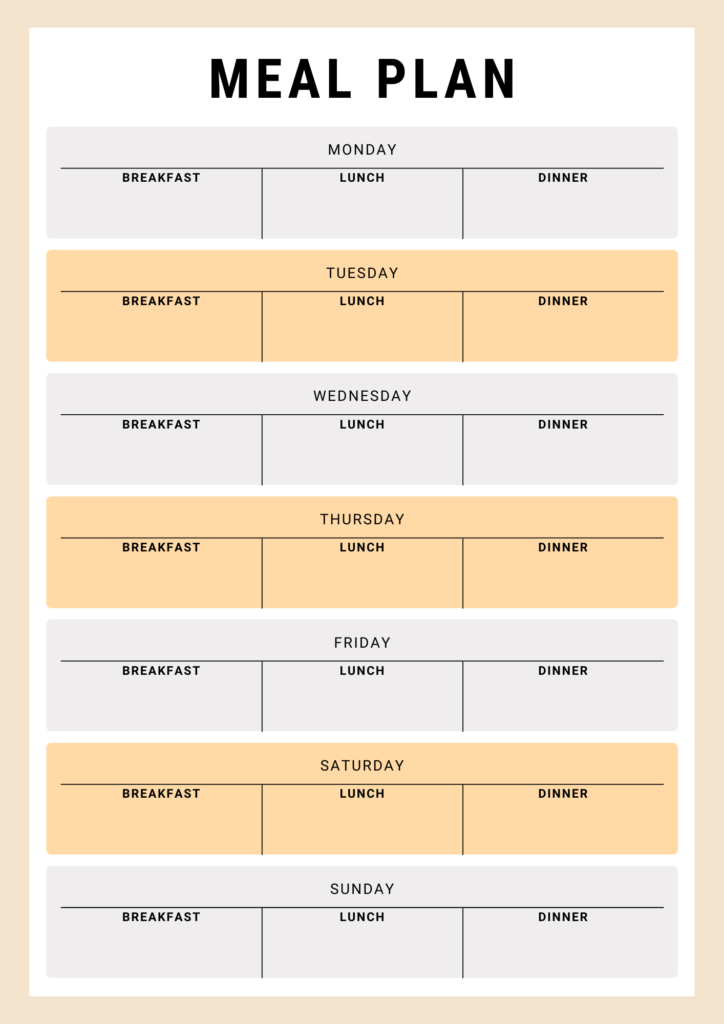
Here’s a simple 7-day balanced diet plan that you can follow or modify according to your preferences:
Day 1:
Breakfast: Greek yogurt with mixed berries and a tablespoon of honey.
Lunch: Grilled chicken salad with mixed greens, cherry tomatoes, cucumber, and a light vinaigrette.
Dinner: Baked salmon with steamed broccoli and quinoa.
Snack: A small handful of almonds and an apple.
Day 2:
Breakfast: Oatmeal with chopped fruit, a sprinkle of cinnamon, and a drizzle of honey.
Lunch: Turkey and avocado wrap with whole-grain tortilla, lettuce, and tomato.
Dinner: Vegetable stir-fry with tofu and brown rice.
Snack: Baby carrots and hummus.
Day 3:
Breakfast: Green smoothie with spinach, banana, almond milk, and a scoop of protein powder.
Lunch: Lentil soup with a mixed greens salad and a slice of whole-grain bread.
Dinner: Grilled shrimp with whole-grain pasta and a side of asparagus.
Snack: A small serving of low-fat cottage cheese and pineapple.
Day 4:
Breakfast: Two scrambled eggs, sautéed spinach and mushrooms, and a slice of whole-grain toast.
Lunch: Quinoa and black bean salad with mixed vegetables and a light lime dressing.
Dinner: Baked chicken breast with roasted sweet potatoes and green beans.
Snack: A small bowl of air-popped popcorn and a tangerine.
Day 5:
Breakfast: Overnight chia seed pudding with almond milk, chopped nuts, and dried fruit.
Lunch: Caprese salad with fresh basil, mozzarella, tomatoes, and a drizzle of balsamic glaze.
Dinner: Turkey chili with kidney beans, bell peppers, and onions, served with a side of brown rice.
Snack: Greek yogurt with a tablespoon of almond butter and a drizzle of honey.
Day 6:
Breakfast: Whole-grain cereal with skim milk and a sliced banana.
Lunch: Grilled vegetable panini with pesto and a side of mixed greens.
Dinner: Baked cod with quinoa, steamed zucchini, and a lemon wedge.
Snack: A small handful of walnuts and a pear.
Day 7:
Breakfast: Whole-grain waffles with fresh berries and a dollop of Greek yogurt.
Lunch: Chicken and vegetable stir-fry with brown rice.
Dinner: Veggie-stuffed bell peppers with a side of mixed greens and a light vinaigrette.
Snack: A small serving of edamame and a kiwi.
Remember to drink plenty of water throughout the day, and adjust portion sizes according to your individual needs and activity levels. This balanced diet plan incorporates a variety of food groups, ensuring you consume the necessary nutrients for overall health and well-being.
3. Incorporate Regular Exercise for Weight Loss success
Incorporating regular exercise into your routine is crucial for weight loss success. Exercise helps burn calories and improves overall health, mood, and energy levels.
Here are some tips for incorporating regular exercise into your weight loss plan:
Choose activities you enjoy
Engaging in exercises you genuinely enjoy increases the likelihood of sticking to your fitness routine. Try various activities such as swimming, dancing, cycling, or hiking to find what suits you best.
Start with moderate-intensity workouts.
Begin with moderate-intensity exercises, such as brisk walking, light jogging, or swimming, to help your body gradually adjust to physical activity.
Incorporate strength training
Strength training, such as weightlifting or bodyweight exercises, can help increase muscle mass, which boosts your metabolism and aids in weight loss.
Combine cardio and strength training.
A well-rounded fitness plan includes both cardiovascular and strength training exercises. Aim for at least 150 minutes of moderate-intensity aerobic activity or 75 minutes of vigorous-intensity aerobic activity per week, along with muscle-strengthening activities on two or more days per week.
Set realistic exercise goals.
Establish achievable exercise goals, such as working out for 30 minutes a day, five days a week. As your fitness improves, you can gradually increase the duration and intensity of your workouts.
Schedule exercise into your daily routine
Treat exercise like an important appointment by setting aside dedicated time for physical activity. Create a weekly workout schedule to help you stay consistent and accountable.
Track your progress
Use a fitness tracker, mobile app, or journal to monitor your exercise routine, which can help you stay motivated and measure your progress over time.
Find a workout buddy.
Having a workout partner can provide support, motivation, and accountability, making it more enjoyable and easier to stick to your exercise plan.
Listen to your body
Pay attention to your body’s signals and adjust your workout routine as needed. Rest and recovery are essential for preventing injuries and promoting overall health.
Celebrate milestones
Recognize and celebrate your fitness achievements, no matter how small, to keep yourself motivated and focused on your weight loss goals.
Remember, consistency is key when it comes to exercise and weight loss success. Start slowly, set realistic weight loss goals, and gradually increase your workout intensity and duration as your fitness level improves.
4. Monitor Your Progress
Monitoring your progress is an essential part of any weight loss journey. Regularly tracking your progress helps you stay motivated, identify areas for improvement, and adjust your plan as needed. Here are some tips for effectively monitoring your progress:

Weigh yourself regularly
Weigh yourself once a week, preferably at the same time of day and under similar conditions. This will help you track your weight loss progress and make adjustments to your diet and exercise routine if necessary.
Take body measurements
Measure your waist, hips, thighs, and other areas of your body to track changes in size. These measurements can provide a more accurate picture of your progress, as muscle gain might offset weight loss on the scale.
Track your food intake.
Use a food journal or a mobile app to record your daily food and beverage consumption. This can help you identify patterns, make healthier choices, and ensure you’re staying within your calorie limits.
Log your exercise
Record your workouts, including the type of exercise, duration, intensity, and frequency. This will help you track your progress, stay accountable, and make adjustments as needed.
Take progress photos
Take photos of yourself regularly (e.g., once a month) to visually document your weight loss journey. Comparing these images over time can be a powerful motivator.
Monitor your energy levels and mood.
Pay attention to how your diet and exercise habits affect your energy levels, mood, and overall well-being. This can help you make adjustments to your plan to optimize your physical and mental health.
Set realistic Weight loss goals and milestones.
Establish specific, measurable, and achievable goals for your weight loss journey. Celebrate milestones along the way to maintain motivation and a sense of accomplishment.
Adjust your plan as needed.
Regularly evaluate your progress and adjust your diet and exercise plan if you do not see the desired results. Be patient, as weight loss is a gradual process and may require experimentation to find your most effective approach.
5. Stay Hydrated
Staying hydrated is crucial for overall health and plays a significant role in weight loss success and weight management. Water is essential for various bodily functions, including digestion, absorption, circulation, temperature regulation, and waste elimination. Here are some tips for staying hydrated throughout the day:

Drink water regularly
Aim to drink at least 8 cups (64 ounces) of water per day or more, depending on your individual needs, climate, and activity levels. Keep a water bottle with you and sip water throughout the day.
Start your day with water.
After waking up, drink a glass of water to jump-start your hydration and metabolism.
Consume water-rich foods
Include fruits and vegetables with high water content in your diet, such as cucumbers, watermelon, oranges, and strawberries.
Replace sugary drinks with water.
Opt for water instead of sugary drinks like soda, fruit juices, and sports drinks. This can help reduce calorie intake and support weight loss.
Flavor your water
If you find plain water unappealing, try infusing it with natural flavors like lemon, cucumber, or mint to make it more enjoyable.
Drink water before meals.
Drinking water before meals can help control your appetite and prevent overeating.
Monitor your urine color.
A simple way to check your hydration status is by observing the color of your urine. Aim for a pale yellow color, which indicates proper hydration.
Adjust your water intake during exercise.
Increase your water consumption during and after exercise to compensate for the fluids lost through sweat.
Listen to your body
Pay attention to your body’s thirst signals, and drink water whenever you feel thirsty.
Remember, staying hydrated is essential for weight loss success and overall health. Make a conscious effort to drink water regularly and incorporate water-rich foods into your diet.
6. Prioritize Sleep
Prioritizing sleep is essential for weight loss success and overall health. Adequate sleep helps regulate hormones, supports a healthy metabolism, and aids in physical recovery and mental well-being. Here are some tips for prioritizing sleep and improving your sleep quality:

Establish a consistent sleep schedule
Go to bed and wake up at the same time every day, even on weekends. This helps regulate your body’s internal clock and improves sleep quality.
Create a bedtime routine.
Develop a relaxing pre-sleep routine to signal your body that it’s time to wind down. This may include activities such as reading, taking a warm bath, or practicing gentle stretches.
Limit screen time before bed.
Exposure to blue light from electronic devices can interfere with producing the sleep hormone melatonin. Reduce screen time at least an hour before bedtime to promote better sleep.
Optimize your sleep environment.
Create a comfortable and relaxing sleep environment by keeping your bedroom cool, dark, and quiet. Invest in a comfortable mattress and pillows that support your preferred sleep position.
Watch what you eat and drink.
Avoid heavy meals, caffeine, and alcohol close to bedtime, as they can disrupt your sleep. Instead, opt for a light snack or a warm, non-caffeinated beverage like herbal tea.
Incorporate physical activity
Regular exercise can help improve sleep quality and duration. However, avoid intense workouts close to bedtime, as they may have a stimulating effect and make it harder to fall asleep.
Manage stress
Practice stress-reducing techniques such as deep breathing, meditation, or yoga to help calm your mind and promote better sleep.
Limit daytime naps
While short naps can be beneficial, long or irregular napping during the day can negatively affect your nighttime sleep quality. Aim to keep naps brief (20-30 minutes) and early in the day.
Seek professional help if needed.
If you continue to struggle with sleep despite implementing these strategies, consider consulting a healthcare professional or a sleep specialist for further evaluation and guidance.
Remember, prioritizing sleep is crucial for weight loss success and overall health. Establish good sleep habits, create a relaxing bedtime routine, and optimize your sleep environment to ensure you get the restorative rest your body needs.
7. Build a Support System
Building a support system is important to a successful weight loss journey. A network of people who encourage, motivate, and hold you accountable can significantly improve your chances of reaching your goals. Here are some tips for building a strong support system:

Share your goals
Let your friends, family, and colleagues know about your weight loss goals and the reasons behind them. Sharing your intentions can help you gain encouragement and support from the people around you.
Find a workout buddy.
Having a workout partner can make exercising more enjoyable and help you stay committed to your fitness routine. Choose someone with similar goals and fitness levels, and schedule regular workout sessions together.
Join a weight loss group or club.
Participate in local or online weight loss groups, clubs, or forums where you can connect with others who share your goals. These communities can provide valuable advice, motivation, and camaraderie.
Seek professional guidance
Consider working with a personal trainer, dietitian, or health coach to receive personalized guidance, support, and accountability throughout your weight loss journey.
Leverage social media
Use social media platforms to connect with others pursuing similar goals, share your progress, and gain inspiration from others’ success stories. Be sure to follow accounts that promote healthy, sustainable weight loss strategies.
Celebrate milestones
Share your achievements with your support network and celebrate your progress together. Recognizing your accomplishments can help maintain motivation and reinforce the importance of your weight loss success.
Be open to feedback
Listen to the advice and suggestions from your support system and be willing to make adjustments to your plan as needed. Everyone’s journey is unique, and what works for one person may not work for another.
Offer support to others.
Be an active member of your support network by offering others encouragement, advice, and motivation. Helping others can also reinforce your commitment to your own goals and foster a sense of community.
Remember, building a strong support system can greatly improve your chances of weight loss success. Surround yourself with positive, like-minded individuals who share your goals and can provide encouragement, motivation, and accountability throughout your journey.
8. Make Lifestyle Changes
Making sustainable lifestyle changes is crucial for long-term weight loss success and overall health improvement. Instead of focusing on quick fixes or extreme diets, adopt healthy habits that can be maintained over time.
How to Implement the Weight Loss Success Plan
Certainly! Here is a comprehensive weight loss success plan that incorporates the essential components of sustainable weight loss:
1. Set realistic weight loss goals
Determine your target weight loss goal and timeframe (e.g., lose 20 pounds in 4 months).
Break down your overall goal into smaller, more achievable milestones (e.g., lose 5 pounds per month).
2. Develop a balanced meal plan
Focus on consuming nutrient-dense foods, including fruits, vegetables, lean proteins, whole grains, and healthy fats.
Limit processed foods, added sugars, and unhealthy fats.
Plan your meals and snacks in advance to ensure you have healthy options readily available.
3. Incorporate portion control
Be mindful of portion sizes and serving recommendations.
Use smaller plates, eat slowly, and pay attention to hunger and fullness cues.
4. Stay hydrated
Aim to drink at least 8 cups (64 ounces) of water daily.
Replace sugary drinks with water, herbal tea, or other low-calorie options.
5. Establish a regular exercise routine
Aim for at least 150 minutes of moderate-intensity aerobic exercise or 75 minutes of vigorous-intensity aerobic exercise per week.
Include strength training exercises for all major muscle groups at least two days per week.
Choose activities you enjoy and vary your workouts to avoid boredom and promote consistency.
6. Prioritize sleep
Establish a consistent sleep schedule by going to bed and waking up at the same time every day.
Create a relaxing bedtime routine and optimize your sleep environment.
Aim for 7-9 hours of quality sleep each night.
7. Manage stress
Incorporate stress-reducing techniques such as deep breathing, meditation, yoga, or journaling into your daily routine.
8. Build a support system
Share your goals with friends, family, and colleagues.
Find a workout buddy or join a weight loss group or club.
Consider seeking professional guidance from a personal trainer, dietitian, or health coach.
9. Track your progress
Keep a food diary, track your workouts, or use a weight loss app to monitor your progress.
Regularly assess your progress and make adjustments to your plan as needed.
10. Stay patient and persistent
Remember that sustainable weight loss takes time and requires consistent effort.
Stay committed to your goals, and be prepared to face challenges and setbacks along the way.
By following this weight loss success plan, you can create a solid foundation for achieving your weight loss goals and improving your overall health.
Wrap Up
Achieving weight loss is a multi-faceted journey involving setting realistic goals, adopting a balanced diet, incorporating regular exercise, and maintaining healthy habits. By following these strategies and staying committed to your goals, you can achieve lasting weight loss results and enjoy a healthier lifestyle.


